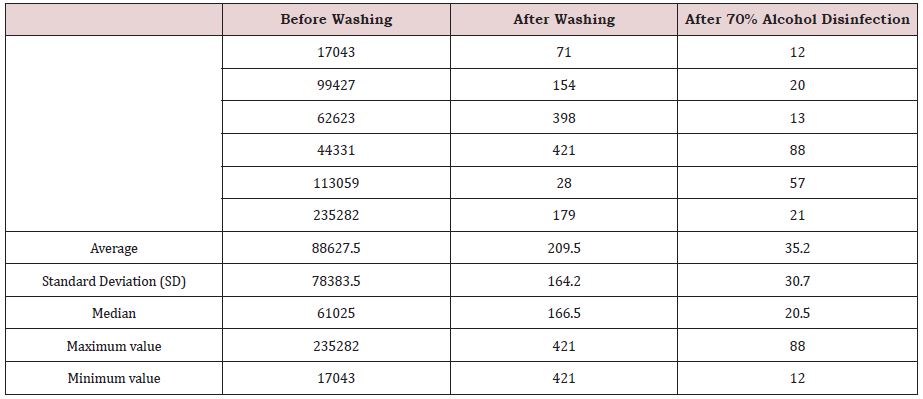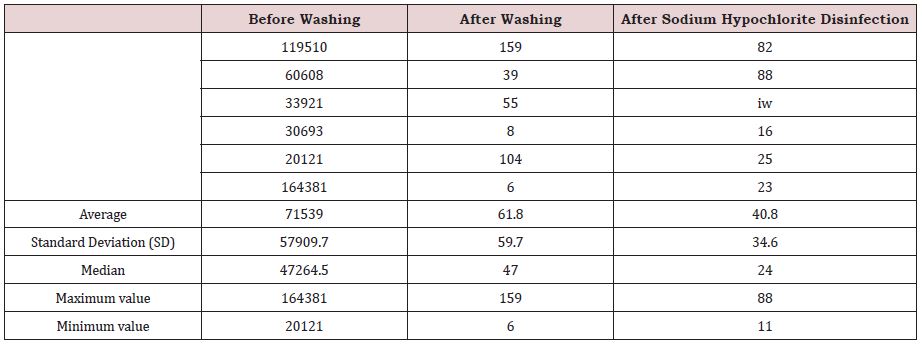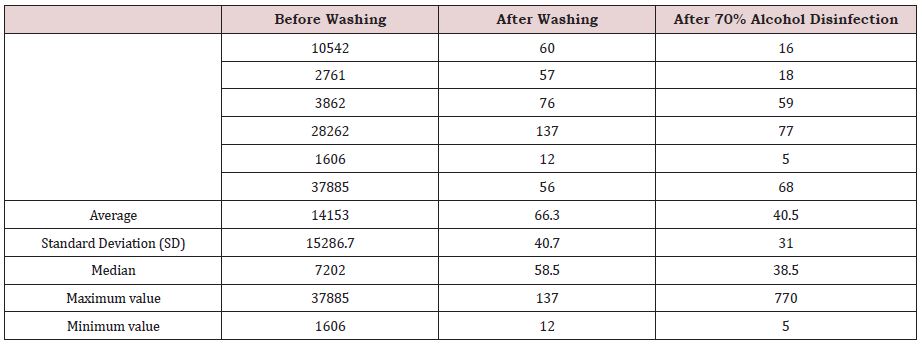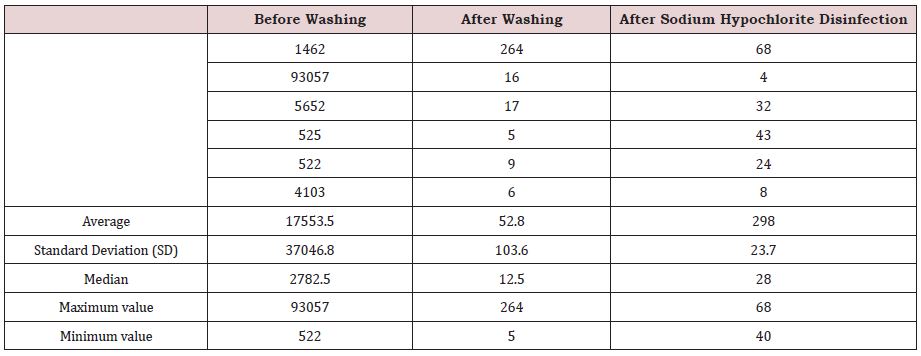Comparison of 70% Alcohol Disinfection and Sodium Hypochlorite Acid Disinfection on Kitchen Knife Blades, Handles and Cutting Boards
ABSTRACT
Purpose: In hygiene management in the kitchen, it is important to disinfect kitchen knives and cutting boards, which are often
touched by human hands and food. It has become with COVID-19, and there is a demand for even more hygienic kitchen utensils.
However, had to lack of supplies, there were times when it was difficult of obtain 70% alcohol, so the kitchen was temporarily
disinfected with sodium hypochlorite. This time, we compared the results of ATP wiping inspections on the blade and handle
(stainless steel) of kitchen knives and cutting board (plastic) that were disinfected with sodium hypochlorite obtained by electrolysis
of salt water or 70% alcohol disinfection. We will report that obtained the target basics-hygiene data.
Materials and Methods: Using 6 kitchen knives, just after cooking and after cleaning the blade and handle of kitchen knife and
after alcohol disinfection and sodium hypochlorite disinfection, use kikkoman’s simple ATP wiping test kit to obtain the ATP value.
As same as, of 12 cutting boards, just after cooking and after washing the cutting boards and after alcohol disinfection and sodium
hypochlorite disinfection, use kikkoman’s simple ATP wiping test kit to obtain the ATP value.
Results: As a result, in all tests, the ATP value was lower after washing than before washing in a series of investigations. In
addition, there was no statistically significant difference between after washing and after disinfection in a series of investigations.
However, the ATP value after disinfection was 100 or less, which met the standard value for hygienic handling. In addition, there
was no statistically significant difference in the comparison of ATP values between the blade and handle of the kitchen knife after
disinfection with 70% alcohol and after disinfection with sodium hypochlorite. On the cutting board, there is a statistically significant
difference in ATP value after 70% alcohol disinfection and sodium hypochlorite disinfection, indication that the ATP value after
alcohol disinfection is lower than that after sodium hypochlorite disinfection.
Discussion: Both after 70% alcohol disinfection and after sodium hypochlorite disinfection, the ATP value was 100or less,
which met the standard value for hygienic handling. However, we think that 70% alcohol disinfection is good according to HACCP
as much as possible. Since there is a possibility of shortage of supplies in the event of an emergency in the future, considering the
reduction of running costs and considering the effectiveness of sodium hypochlorite disinfection, it is recommended to use it in
combination with 70% alcohol disinfection.
KEYWORDS
ATP wiping inspection; Microbial test; Cutting board; Knife blade; Knife handle
INTRODUCTION
Regarding the hygiene management of kitchens, it was required to strictly adhere to HACCP, but from June 2021, it became mandatory to fully introduce it to food-related business formats. This forced the stricter hygiene control in the kitchen. It will be with corona from 2020, and hygienic behavior was required by putting more effort into hand hygiene and disinfection of cooking utensils. Although it was temporary, it became difficult to obtain 70% alcohol for disinfection, and there was a time when the kitchen was cleaned using sodium hypochlorite obtained by electrolyzing saline solution. Sodium hypochlorite is also frequently used in kitchens because it is also used to sterilize foods (vegetables, etc.). Therefore, it was possible to use it without any resistance for washing the inside of the kitchen with sodium hypochlorite. However, it is not clear how hygienic it is compared to 70% alcohol.
PURPOSE
Therefore, some study compared he effects of 70% alcohol and sodium hypochlorite on the disinfection of kitchen knives and cutting boards, which are often touched by human hands and food in the kitchen, using ATP values, and it is still less clear. This study is the aim to get basic data on the effects of 70% alcohol disinfection and sodium hypochlorite disinfection on the hygiene.
MATERIALS AND METHODS
The ATP values were obtained by performing an ATP wiping inspection on the blades and handles of the six kitchen knives immediately after cooking and before washing using an ATP inspection kit manufactured by Kikkoman. After further washing, the ATP value was obtained in the same manner. After that, 70% alcohol disinfection or sodium hypochlorite disinfection was performed, and the ATP value was obtained in the same manner. On 12 cutting boards, the ATP value before cleaning after cooking was inspected by wiping with ATP using a Kikkoman Lumitester and Lucipac. After further washing, the ATP value was obtained in the same manner. After that, alcohol disinfection or sodium hypochlorite disinfection was performed, and the ATP value was obtained in the same manner. The obtained data was statistically calculated using Excel statistics (SSRI Co., Ltd.). In a series of tests (before washing, after washing, after disinfection), F-test was performed for the purpose of examining the presence or absence of a normal distribution for the first two groups to be compared. As a result, if there was no significant difference, it was normally distributed, so the paired student-t test was performed. If there was a significant difference, it was not normally distributed, so statistical processing was performed using the paired Wilcoxon test. In order to compare the ATP values of alcohol disinfection and sodium hypochlorite disinfection, F-test was performed for the purpose of examining the presence or absence of a normal distribution for the two groups to be compared. As a result, if there is no significant difference, it is normally distributed, so the unpaired Student-t test was performed. In addition, if there is a significant difference, the distribution is not normally distributed, so statistical processing was performed using the unpaired Mann-Whitney test.
RESULTS
Table 1 shows the results of the tables of the blades of six knives that have been sterilized with 70% alcohol. The results of the ATP wipe test value performed immediately after cooking, the ATP wipe test value result performed after washing, and the ATP wipe test value result performed after70% alcohol disinfection are shown. Compared to before washing, the removal rate was 99.7% after washing, and by disinfecting with alcohol, the removal rate was 99.96% compared to before washing. The removal rate after alcohol disinfection was 83.19% compared to that after washing.
Table 2 shows the results of the blades of six kitchen knives that have been disinfected with sodium hypochlorite. The results of the ATP wipe test value performed immediately after cooking, the ATP wipe test value result performed after washing, and the ATP wipe test value result performed after sodium hypochlorite disinfection are shown. Compared to before washing, the removal rate was 99.91% after washing, and by disinfecting with sodium hypochlorite, the removal rate was 99.94% compared to before washing. The removal rate after sodium hypochlorite disinfection was 33.98% compared to that after washing.
Table 3 shows the results of the handles of six knives that have been sterilized with 70% alcohol. The results of the ATP wipe test value performed immediately after cooking, the ATP wipe test value result performed after washing, and the ATP wipe test value result performed after70% alcohol disinfection are shown.
Compared to before cleaning, the removal rate was 99.53% after washing, and by disinfecting with alcohol, the removal rate was 99.70% compared to before washing. The removal rate after alcohol disinfection was 38.91% compared to that after washing.
Table 4 shows the results of the handles of six kitchen knives that have been disinfected with sodium hypochlorite.
The results of the ATP wipe test value performed immediately after cooking, the ATP wipe test value result performed after washing, and the ATP wipe test value result performed after sodium hypochlorite disinfection are shown.
Compared to before cleaning, the removal rate was 99.69% after washing, and by disinfecting with sodium hypochlorite, the removal rate was 99.83% compared to before washing. The removal rate after sodium hypochlorite disinfection was 43.56% compared to that after washing.
Since it was shown that the ATP value was considerably low before and after washing, and 70% alcohol disinfection or sodium hypochlorite disinfection, it was examined whether there was a statistically significant difference. The ATP values of 70% alcohol- sterilized kitchen knife blades were statistically compared. As a result, the ATP value was statistically significantly lower after washing than before washing (P<0.05), after 70% alcohol disinfection than before washing (P<0.05), and after 70% alcohol disinfection than after washing (P<0.05) (Table 5).
The ATP values of sodium hypochlorite disinfection sterilized kitchen knife blades were statistically compared. As a result, the ATP value was statistically significantly lower after washing than before washing (P<0.05), after sodium hypochlorite disinfection than before washing (P<0.05). But, after sodium hypochlorite disinfection than after washing was not statistically significantly different (P>0.05) (Table 6).
The ATP values of 70% alcohol- sterilized kitchen knife handles were statistically compared. As a result, the ATP value was statistically significantly lower after washing than before washing (P<0.05), after 70% alcohol disinfection than before washing (P<0.05). But, after 70% alcohol disinfection than after washing was not statistically significantly different (P>0.05) (Table 7).
The ATP values of sodium hypochlorite disinfection sterilized kitchen knife handles were statistically compared. As a result, the ATP value was statistically significantly lower after washing than before washing (P<0.05), after sodium hypochlorite disinfection than before washing (P<0.05). But, after sodium hypochlorite disinfection than after washing was not statistically significantly different (P>0.05) (Table 8).
Similarly, about the handle of the kitchen knife, the ATP values of 70% alcohol disinfection and sodium hypochlorite disinfection were statistically compared. As a result, the knife handles were compared before, after and after disinfection, respectively, but there was no statistically significant difference in any of the cases (P >0.05) (Table 10).
Next, Table 11 shows the results of 70% alcohol disinfection of 12 cutting boards. The ATP value that was wiped and inspected after cooking and before washing was compared with the ATP value that was wiped and inspected after washing and the ATP value that was wiped and inspected after 70% alcohol disinfection. The removal rete after washing was 99.92% compared to before washing, and the removal rate was 99.97% after washing by 70% alcohol disinfection. The ATP value was 68.05% after 70% alcohol disinfection compared to before washing.
Table 12 shows the results of sodium hypochlorite disinfection of 12 cutting boards. The ATP value that was wiped and inspected after cooking and before washing was compared with the ATP value that was wiped and inspected after washing and the ATP value that was wiped and inspected after sodium hypochlorite disinfection. The removal rete after washing was 99.95% compared to before washing, and the removal rate was 99.94% after washing by sodium hypochlorite disinfection. The ATP value was 22.33% after sodium hypochlorite disinfection compared to after washing.
The ATP values of 70% alcohol-sterilized cutting boards were statistically compared. As a result, the ATP value was statistically significantly lower after washing (P<0.01) than before washing, after 70% alcohol disinfection than before washing (P<0.01), and after 70% alcohol disinfection than after washing (P<0.05) (Table 13).
The ATP values of sodium hypochlorite -sterilized cutting boards were statistically compared. As a result, the ATP value was statistically significantly lower after washing (P<0.01) than before washing, after sodium hypochlorite disinfection than before washing (P<0.01). However, there was no statistically significant difference after sodium hypochlorite disinfection than after washing (P<0.05) (Table 14).
For cutting boards, the AT values of 70% alcohol disinfection and sodium hypochlorite disinfection were statistically compared. As a result, the results before and after each washing were compared, but there was no statistically significant difference in either case (P>0.05). However, it was shown that the ATP value was statistically significantly lower after 70% alcohol disinfection and after sodium hypochlorite disinfection (P<0.01) (Table 15).
DISCUSSION
Many researchers have achieved hygiene management in hospitals and other kitchens through hygiene education [1-4]. In particular, hygiene management using the ATP wiping test made it possible to create an easy-to-understand and hygienic environment by expressing invisible microorganisms as ATP values [5-8]. In the past, we also reported the results of hygiene tests on kitchen utensils using ATP wiping test [9-11].
From the above, washing itself is very important in hygiene management of kitchen knife blades and handles those human hands touch, and cutting boards that food frequently touches, and 70% alcohol disinfection and sodium hypochlorite disinfection are effective. In kitchen knives, both 70% alcohol and sodium hypochlorite had an ATP value of 100 or less after disinfection, indicating that they meet hygiene standards. Furthermore, on cutting boards, 70% alcohol disinfection was shown to reduce ATP levels statistically significantly more than sodium hypochlorite disinfection. As shown in the HACCP manual, this study also showed that disinfection with 70% alcohol was effective, but sodium hypochlorite was also effective. Sodium hypochlorite, which is produced by electrolysis form saline solution, is low cost than 70% alcohol. In the kitchen, it is necessary to devise ways to reduce running costs by using two types of disinfectants properly according to the amount of work. It is considered effective to maintain a hygienic environment flexibly bi constantly disinfecting with inexpensive sodium hypochlorite and performing 70% alcohol disinfection based on HACCP when washing cooking ware. In the event of a shortage of supplies that may occur again in the future, it is necessary to hedge the risk of disinfection methods. For that purpose, we would like to promote the combined use of 70% alcohol and sodium hypochlorite. With this method, it is considered that hygiene management for providing safe and secure meals can be sufficiently performed while suppressing running costs. We want to use it for hygiene management in the kitchen in the future.
CONCLUSION
It was found that both 70% alcohol and sodium hypochlorite statistically significantly reduce the ATP values of kitchen knife blades, handles and cutting boards. It was also shown that both 70% alcohol and sodium hypochlorite and inferior disinfection methods. According to HACCP, disinfection with 70% alcohol at the main important control points will be continued, and it is considered that the hygiene management of the kitchen incorporating sodium hypochlorite disinfection in consideration of running cost in other parts will be useful in the future.
ACKNOWLEDGMENT
We would like to express our deep gratitude of all the cooks who cooked this research.
REFERENCES
- Aycieck H, Oquz U, Karci K (2006) Comparison of results of ATP bioluminescence and traditional hygiene swabbing methods from the determination of surface cleanliness at a hospital kitchen. Int J Hyg Environ Health 209(2): 203-206.
- Osimani A, Garofalo C, Clementi F, Tavoletti S, Aquilanti L (2014) Bioluminescence ATP monitoring for the routine assessment of food contact surface cleanliness in a university canteen. Int J Environ Res Public Health 11(10): 10824-10837.
- Lee JH (2018) An investigation of Factors that influence Hygiene Practices at a small Day Care Center. J Food Prot 81(1): 158-164.
- Griffith CJ, Coooper RA, Gilmore J, Davies C, Lweis M (2000) An evaluation of hospital cleaning regimes and standards. J Hosp Infect 45(1): 19-28.
- Stannard CJ, Gibbs PA (1986) Rapid microbiology: Application s of bioluminescence in the food industry- A review. J Biolumin Chemilumin 1(1): 3-10.
- Nante N, Ceriale E, Messina G, Lenzi D, Manzi P (2017) Effectiveness of ATP bioluminescence to assess hospital cleaning: a review. J Prev Med Hyg 58(2): E177-E183.
- Amodio E, Dubi C (2014) Use of ATP bioluminescence for assessing the cleanliness of hospital surfaces: A review of the published literature (1990-2012). J Infect Public Health 7(2): 92-98.
- Stanley PE (1989) A review of bioluminescent STP techniques in rapid microbiology. J Biolumin Chemilumin 4(1): 375-380.
- Katayama N, Ito A, Hirabayashi M, Kondo S, Nakayama Y, et al. (2020) Results of hygiene education of kitchen knife by using ATP inspectioncomparison of handle and blade. Global Journal of Medical Research. 20(5): 1-6.
- Katayama N, Hirabayashi M, Ito A, Kondo S, Nakayama Y, et al. (2020) Results of hygiene education of kitchen cutting board by using ATP inspection - comparison of vegetable cutting board and meat cutting board. Global Journal of Medical Research 20(5):13-16.
- Katayama N, Kondo S, Ito A, Hirabayashi M, Nakayama Y, et al. (2020) Results of hygiene education of kitchen stove knob and water faucet by using ATP inspection. Global Journal of Medical Research 20(5): 35-38.
Article Type
Research Article
Publication history
Received Date: November 02, 2021
Published: November 22, 2021
Address for correspondence
Naomi Katayma, Faculty of Health Sciences, Department of Health and Nutrition, Nagoya Women’s University, 3-40, Shioji-cyo, Mizuho-ku, Nagoya city, Aichi, 467-8610, Japan
Copyright
©2021 Open Access Journal of Biomedical Science, All rights reserved. No part of this content may be reproduced or transmitted in any form or by any means as per the standard guidelines of fair use. Open Access Journal of Biomedical Science is licensed under a Creative Commons Attribution 4.0 International License
How to cite this article
Akemi I, Naomi K. Comparison of 70% Alcohol Disinfection and Sodium Hypochlorite Acid Disinfection on Kitchen Knife Blades, Handles and Cutting Boards. 2021- 3(6) OAJBS.ID.000349.
Table 1: ATP value of the blade of 6 kitchen knives after 70% alcohol disinfection.
Table 2: ATP value of the blade of 6 kitchen knives after sodium hypochlorite disinfection.
Table 3: ATP value of the handle of 6 kitchen knives after 70% alcohol disinfection.
Table 4: ATP value of the handle of 6 kitchen knives after sodium hypochlorite disinfection.
Table 5: Comparison of ATP values of knife blades disinfected with 70% alcohol.
Table 6: Comparison of ATP values of knife blades disinfected with sodium hypochlorite.
Table 7: Comparison of ATP values of knife handles disinfected with 70% alcohol.
Table 8: Comparison of ATP values of knife handles disinfected with sodium hypochlorite.
Table 9: Comparison of ATP values of knife handles when disinfected with sodium hypochlorite and when disinfected with 70% alcohol.
Table 10: Comparison of ATP values of kitchen knife handles when disinfected with sodium hypochlorite and when disinfected with 70% alcohol.
Table 11: ATP value result of cutting board disinfected with 71% alcohol.
Table 12: ATP value result of cutting board disinfected with sodium hypochlorite.
Table 13: Statistical comparison of ATP values for 70% alcohol sterilized cutting boards.
Table 14: Statistical comparison of ATP values for sodium hypochlorite sterilized cutting boards.
Table 15: Statistical comparison of ATP values for cutting boards disinfected with 70% alcohol and sodium hypochlorite.

















